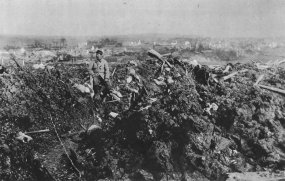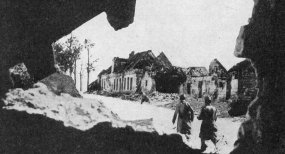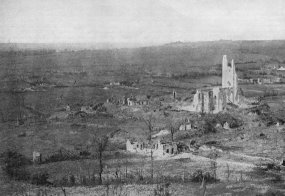
WWII: Maginot Line | Normandy | V-Weapon Sites | Arnhem
Further afield: Crete
| Home Tracing Military Ancestors Travel Advice CWGC Cemeteries Iron Harvest News Book Reviews Glossary Links Contact Me Artois:
 
|
The Second Battle of Artois and the British Aubers Ridge and Festubert Offensives (May to June 1915)In the spring of 1915, French General Headquarters (GHQ) decided on a major offensive to take back the high ground. During the winter of 1914, French forces had managed to establish a foothold on Notre-Dame de Lorette but the intention now was a drive on a narrow four-mile front, supported by a British attack towards Aubers Ridge, designed to capture the whole ridge line and threaten the coal and rail centres of Douai and Lens in the plain beyond. For this ambitious plan, General Foch, commander of the Army Group of the North, had six army corps, from south to north the XXI, XXXIII, XX, XVII, X and, opposite Loos, the IX. North of these were the British I and IV Corps and the Indian Corps. Preparation for the attack was thorough with each infantry unit and artillery battery assigned specific objectives. Morale too was good, and many in the French Army believed this might be the "breakthrough" battle allowing a war of movement to resume. The Germans, however, had put the time since the breakdown of their October offensive to good use, and the defences they had constructed on the slopes of the ridges were formidable. They consisted of trench lines dug in depth fronted by heaps of barbed wire, redoubts packed with machine guns and "boyaux" – deep underground shelters to keep the troops safe from artillery fire. In front of and amongst their positions they had also constructed a number of strongpoints, some formed using the brickwork and cellars of front line villages such as Carency, Ablain-St-Nazaire and Neauville-St-Vaast, others purpose-built and intricate networks of trenches and machine-gun posts like the "Labyrinth" to the south-east of Neauville-St-Vaast, the "Ouvrages Blancs" south of Souchez and on the summit of Notre-Dame de Lorette spur. At 0600 on 9th May 1915, preceded by a massive six-day bombardment by 1,200 guns, the attack went in. Initially the weight of gunfire support seemed to work – in the centre Petain’s XXXIII Corps, spearheaded by the Moroccan and 77th Divisions, smashed through the “Ouvrages Blancs” and incredibly reached the crest of Vimy Ridge itself – an advance of 4½km in just over an hour! Unfortunately, however, the French reserves had been placed too far back and could not be got forward quickly enough to exploit the success. The Germans regained their balance, bringing up troops in lorries to counter-attack the French, forcing them from the summit. Elsewhere, gains were less dramatic – the Germans successfully using their strongpoints to dissipate the force of the assault. On Notre-Dame de Lorette the French spent four days inching their way through the German defences under intense machine gun and rifle fire. Eventually, on 12th May, they reached the summit where the Ossuary stands today, although it would be another ten days before the entire feature was in French hands. Carency also fell on 12th May, but not before it had been entirely surrounded by the French. Ablain-St-Nazaire, in the shadow of the Notre-Dame spur held out until 29th May and was only captured after three days of bitter fighting. On the right of the attack, progress was even slower. Fighting for the village of Neauville-St-Vaast continued throughout May and it was only on 9th June that the French took the northern part of the village. The Labyrinth resisted even longer – the whole position only being secured on 17th June after a bombardment consisting of hundreds of thousands of shells literally blew the German defenders out of their honeycomb of trenches, dugouts and machine-gun posts. With casualties mounting for ever more limited gains, the French GHQ closed the offensive a few days later. Meanwhile, to the north, the British support operation, launched at 0540 on 9th May, had been nothing short of a disaster. Because of a shortage of shells and of larger calibre guns, the artillery bombardment preceding the attack was wholly inadequate. Lasting only 40 minutes it failed to destroy the German wire or inflict significant casualties on the defenders, who swarmed out to meet their assailants when the barrage lifted. The southern part of the attack, launched to the south of Neuve-Chapelle and consisting of the 1st and Meerut Divisions, never got much further than the German wire – many men being killed or wounded by German fire as they climbed out of their own trenches. By 0800, the 2nd and 3rd Brigades of 1st Division had taken 60% casualties. The northern attack, consisting of the 24th and 25th Brigades of the 8th Division, fared slightly better at first assisted by the detonation of two mines, but soon broke down as German machine-gun and rifle fire took their toll. The 1/13th London (Kensington) Regiment did manage to make some headway but the narrowness of their incursion into the German frontline meant it was impossible to bring up reinforcements to exploit their limited success. By nightfall the action was called off. Despite this setback, the British planned a further support operation, further south around Festubert. The British hoped that this time the combination of a two-day bombardment and night attack would give them a good chance of cracking the German front and attracting German reserves up from the Vimy sector. The attack was launched at 2330 on 15th May and, initially made some progress on the 2nd and 7th Division fronts. This was deceptive, however, as the Germans had been preparing a new defensive line 900 yards further back and this effectively stopped the advance on the 16th May. A further attack by the Canadian and 51st Highland Divisions on the night of 25th May failed to make any further headway and, with artillery ammunition again running dangerously low, the Festubert offensive was halted. For an assault that began with high hopes of breaching the German defences north east of Arras, the battles of May and June were a major disappointment for the Allies. True, Notre-Dame de Lorette was in French hands along with a string of front-line villages, but the key feature of Vimy Ridge was still held by the Germans and Allied positions in front of it were dangerously exposed to German fire. Casualties too were horrific – 140,000 French, 70,000 German and nearly 30,000 British soldiers. The French and British armies had displayed great élan but had ultimately been thwarted by a tenacious and well dug in enemy. Even worse for future operations in the war, the Allies took away the wrong conclusions – that heavier and more prolonged bombardments and assaulting on a broader front were the answer to overcoming fixed defences. For those who were to fight on the Somme and at Passchendaele, it was a costly misinterpretation. |


